Sustainable Engineering: Chemical Engineering Trends and Solutions
VerifiedAdded on 2023/06/04
|11
|3190
|323
Report
AI Summary
This report provides an overview of sustainable engineering practices within chemical engineering, focusing on the integration of green chemistry principles and sustainable development in industrial processes. It highlights the importance of considering the entire product lifecycle, from production to disposal, and the challenges associated with implementing sustainable solutions, such as consumer willingness to pay. The report discusses development phases, including diversifying and convergence stages, and emphasizes the need for minimizing emissions, recycling, and reducing the use of fossil fuels. It also evaluates product and process development, advocating for the substitution of hazardous components with more environmentally friendly alternatives and exploring methods for reusing and recycling materials, including pyrolysis and incineration. The report concludes that the successful implementation of sustainable practices offers significant opportunities for improvement in chemical engineering, despite existing challenges.
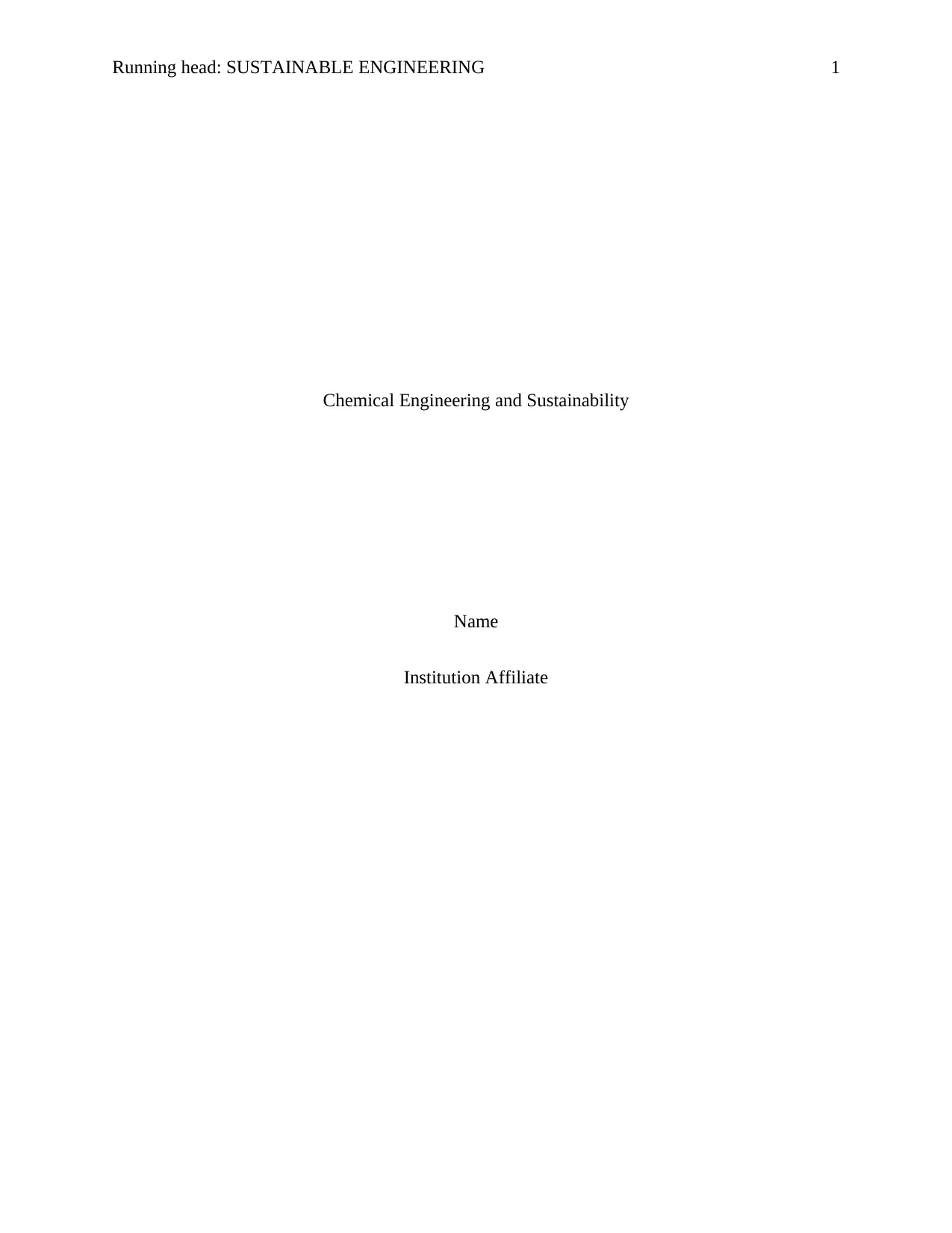
Running head: SUSTAINABLE ENGINEERING 1
Chemical Engineering and Sustainability
Name
Institution Affiliate
Chemical Engineering and Sustainability
Name
Institution Affiliate
Paraphrase This Document
Need a fresh take? Get an instant paraphrase of this document with our AI Paraphraser
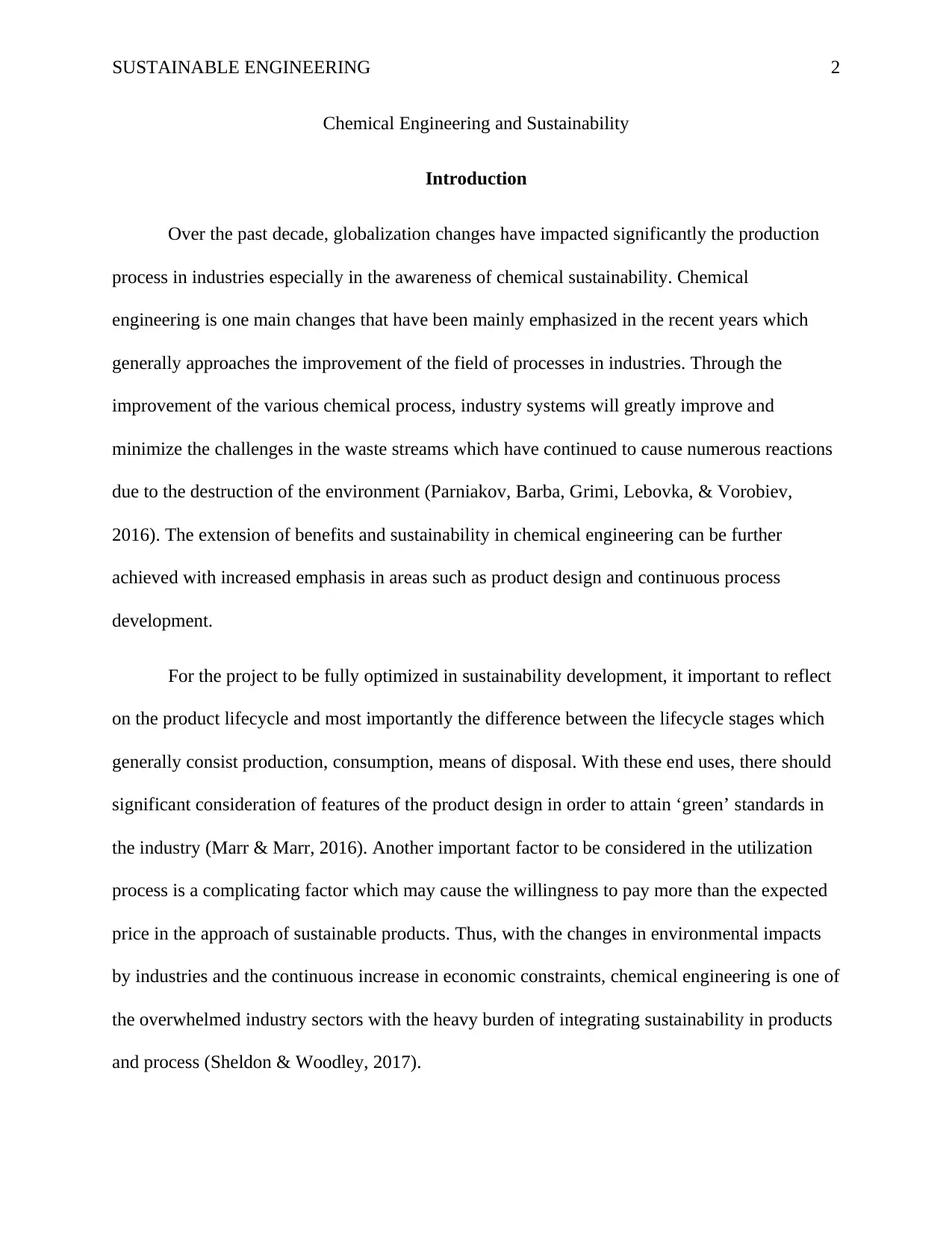
SUSTAINABLE ENGINEERING 2
Chemical Engineering and Sustainability
Introduction
Over the past decade, globalization changes have impacted significantly the production
process in industries especially in the awareness of chemical sustainability. Chemical
engineering is one main changes that have been mainly emphasized in the recent years which
generally approaches the improvement of the field of processes in industries. Through the
improvement of the various chemical process, industry systems will greatly improve and
minimize the challenges in the waste streams which have continued to cause numerous reactions
due to the destruction of the environment (Parniakov, Barba, Grimi, Lebovka, & Vorobiev,
2016). The extension of benefits and sustainability in chemical engineering can be further
achieved with increased emphasis in areas such as product design and continuous process
development.
For the project to be fully optimized in sustainability development, it important to reflect
on the product lifecycle and most importantly the difference between the lifecycle stages which
generally consist production, consumption, means of disposal. With these end uses, there should
significant consideration of features of the product design in order to attain ‘green’ standards in
the industry (Marr & Marr, 2016). Another important factor to be considered in the utilization
process is a complicating factor which may cause the willingness to pay more than the expected
price in the approach of sustainable products. Thus, with the changes in environmental impacts
by industries and the continuous increase in economic constraints, chemical engineering is one of
the overwhelmed industry sectors with the heavy burden of integrating sustainability in products
and process (Sheldon & Woodley, 2017).
Chemical Engineering and Sustainability
Introduction
Over the past decade, globalization changes have impacted significantly the production
process in industries especially in the awareness of chemical sustainability. Chemical
engineering is one main changes that have been mainly emphasized in the recent years which
generally approaches the improvement of the field of processes in industries. Through the
improvement of the various chemical process, industry systems will greatly improve and
minimize the challenges in the waste streams which have continued to cause numerous reactions
due to the destruction of the environment (Parniakov, Barba, Grimi, Lebovka, & Vorobiev,
2016). The extension of benefits and sustainability in chemical engineering can be further
achieved with increased emphasis in areas such as product design and continuous process
development.
For the project to be fully optimized in sustainability development, it important to reflect
on the product lifecycle and most importantly the difference between the lifecycle stages which
generally consist production, consumption, means of disposal. With these end uses, there should
significant consideration of features of the product design in order to attain ‘green’ standards in
the industry (Marr & Marr, 2016). Another important factor to be considered in the utilization
process is a complicating factor which may cause the willingness to pay more than the expected
price in the approach of sustainable products. Thus, with the changes in environmental impacts
by industries and the continuous increase in economic constraints, chemical engineering is one of
the overwhelmed industry sectors with the heavy burden of integrating sustainability in products
and process (Sheldon & Woodley, 2017).
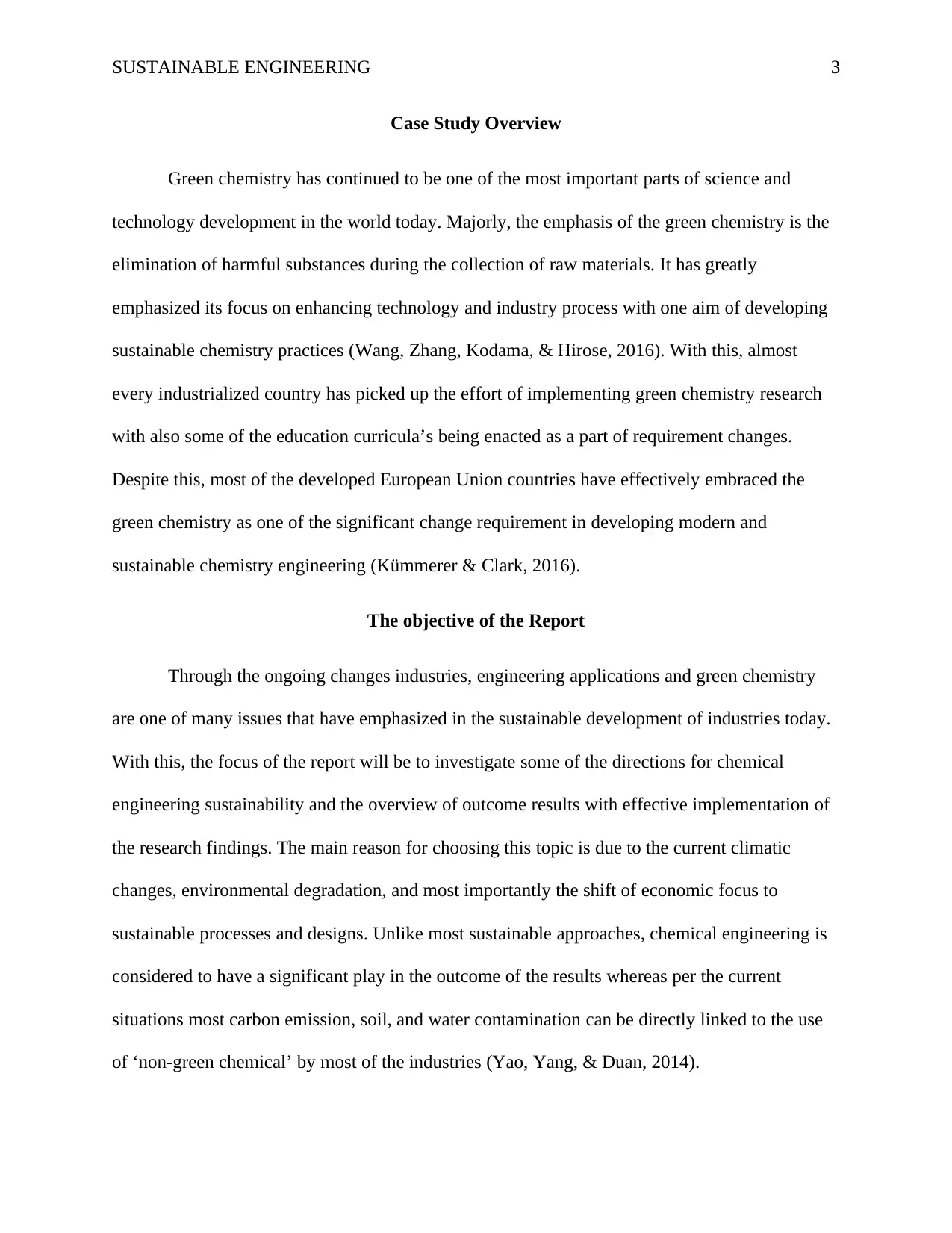
SUSTAINABLE ENGINEERING 3
Case Study Overview
Green chemistry has continued to be one of the most important parts of science and
technology development in the world today. Majorly, the emphasis of the green chemistry is the
elimination of harmful substances during the collection of raw materials. It has greatly
emphasized its focus on enhancing technology and industry process with one aim of developing
sustainable chemistry practices (Wang, Zhang, Kodama, & Hirose, 2016). With this, almost
every industrialized country has picked up the effort of implementing green chemistry research
with also some of the education curricula’s being enacted as a part of requirement changes.
Despite this, most of the developed European Union countries have effectively embraced the
green chemistry as one of the significant change requirement in developing modern and
sustainable chemistry engineering (Kümmerer & Clark, 2016).
The objective of the Report
Through the ongoing changes industries, engineering applications and green chemistry
are one of many issues that have emphasized in the sustainable development of industries today.
With this, the focus of the report will be to investigate some of the directions for chemical
engineering sustainability and the overview of outcome results with effective implementation of
the research findings. The main reason for choosing this topic is due to the current climatic
changes, environmental degradation, and most importantly the shift of economic focus to
sustainable processes and designs. Unlike most sustainable approaches, chemical engineering is
considered to have a significant play in the outcome of the results whereas per the current
situations most carbon emission, soil, and water contamination can be directly linked to the use
of ‘non-green chemical’ by most of the industries (Yao, Yang, & Duan, 2014).
Case Study Overview
Green chemistry has continued to be one of the most important parts of science and
technology development in the world today. Majorly, the emphasis of the green chemistry is the
elimination of harmful substances during the collection of raw materials. It has greatly
emphasized its focus on enhancing technology and industry process with one aim of developing
sustainable chemistry practices (Wang, Zhang, Kodama, & Hirose, 2016). With this, almost
every industrialized country has picked up the effort of implementing green chemistry research
with also some of the education curricula’s being enacted as a part of requirement changes.
Despite this, most of the developed European Union countries have effectively embraced the
green chemistry as one of the significant change requirement in developing modern and
sustainable chemistry engineering (Kümmerer & Clark, 2016).
The objective of the Report
Through the ongoing changes industries, engineering applications and green chemistry
are one of many issues that have emphasized in the sustainable development of industries today.
With this, the focus of the report will be to investigate some of the directions for chemical
engineering sustainability and the overview of outcome results with effective implementation of
the research findings. The main reason for choosing this topic is due to the current climatic
changes, environmental degradation, and most importantly the shift of economic focus to
sustainable processes and designs. Unlike most sustainable approaches, chemical engineering is
considered to have a significant play in the outcome of the results whereas per the current
situations most carbon emission, soil, and water contamination can be directly linked to the use
of ‘non-green chemical’ by most of the industries (Yao, Yang, & Duan, 2014).
⊘ This is a preview!⊘
Do you want full access?
Subscribe today to unlock all pages.

Trusted by 1+ million students worldwide
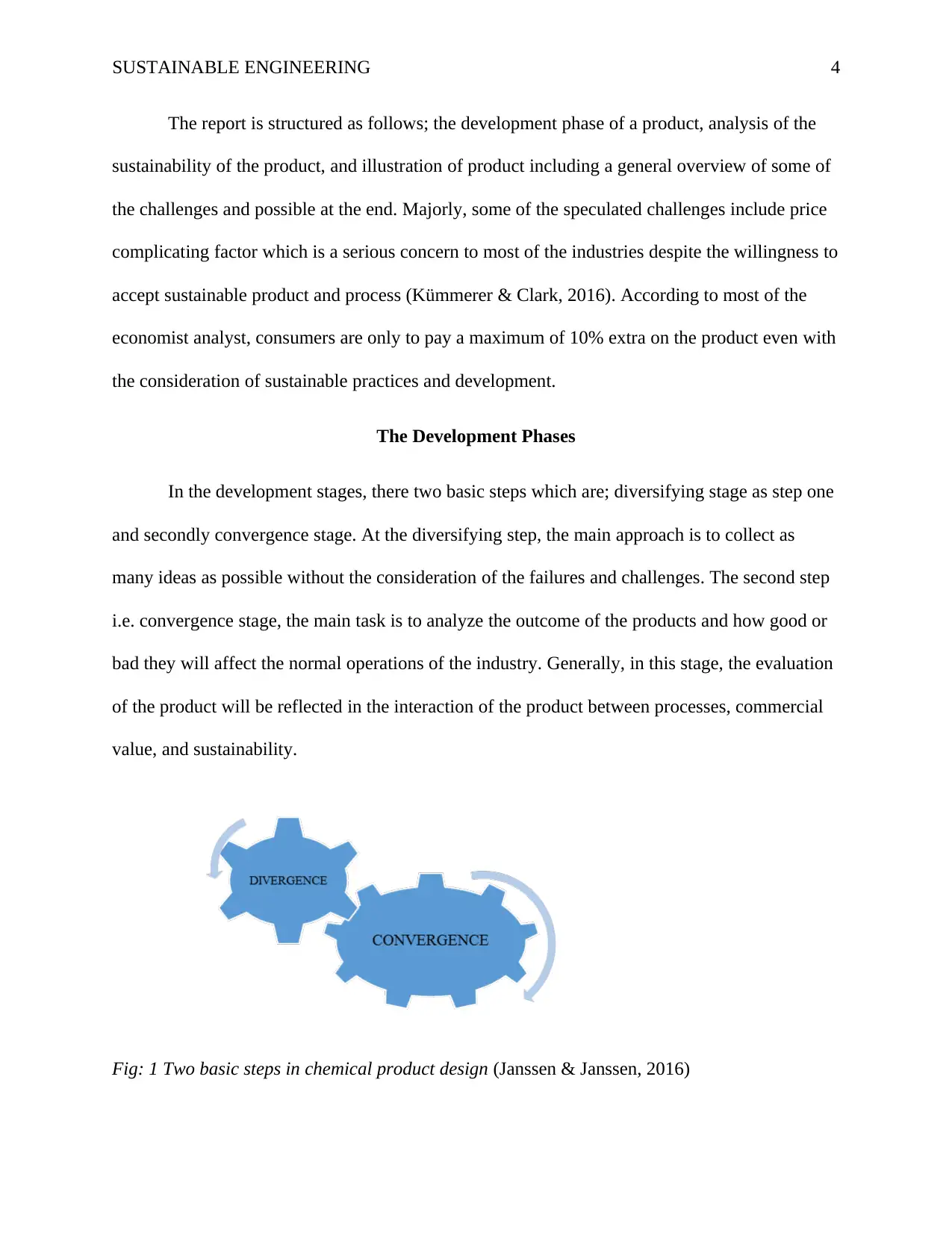
SUSTAINABLE ENGINEERING 4
The report is structured as follows; the development phase of a product, analysis of the
sustainability of the product, and illustration of product including a general overview of some of
the challenges and possible at the end. Majorly, some of the speculated challenges include price
complicating factor which is a serious concern to most of the industries despite the willingness to
accept sustainable product and process (Kümmerer & Clark, 2016). According to most of the
economist analyst, consumers are only to pay a maximum of 10% extra on the product even with
the consideration of sustainable practices and development.
The Development Phases
In the development stages, there two basic steps which are; diversifying stage as step one
and secondly convergence stage. At the diversifying step, the main approach is to collect as
many ideas as possible without the consideration of the failures and challenges. The second step
i.e. convergence stage, the main task is to analyze the outcome of the products and how good or
bad they will affect the normal operations of the industry. Generally, in this stage, the evaluation
of the product will be reflected in the interaction of the product between processes, commercial
value, and sustainability.
Fig: 1 Two basic steps in chemical product design (Janssen & Janssen, 2016)
The report is structured as follows; the development phase of a product, analysis of the
sustainability of the product, and illustration of product including a general overview of some of
the challenges and possible at the end. Majorly, some of the speculated challenges include price
complicating factor which is a serious concern to most of the industries despite the willingness to
accept sustainable product and process (Kümmerer & Clark, 2016). According to most of the
economist analyst, consumers are only to pay a maximum of 10% extra on the product even with
the consideration of sustainable practices and development.
The Development Phases
In the development stages, there two basic steps which are; diversifying stage as step one
and secondly convergence stage. At the diversifying step, the main approach is to collect as
many ideas as possible without the consideration of the failures and challenges. The second step
i.e. convergence stage, the main task is to analyze the outcome of the products and how good or
bad they will affect the normal operations of the industry. Generally, in this stage, the evaluation
of the product will be reflected in the interaction of the product between processes, commercial
value, and sustainability.
Fig: 1 Two basic steps in chemical product design (Janssen & Janssen, 2016)
Paraphrase This Document
Need a fresh take? Get an instant paraphrase of this document with our AI Paraphraser
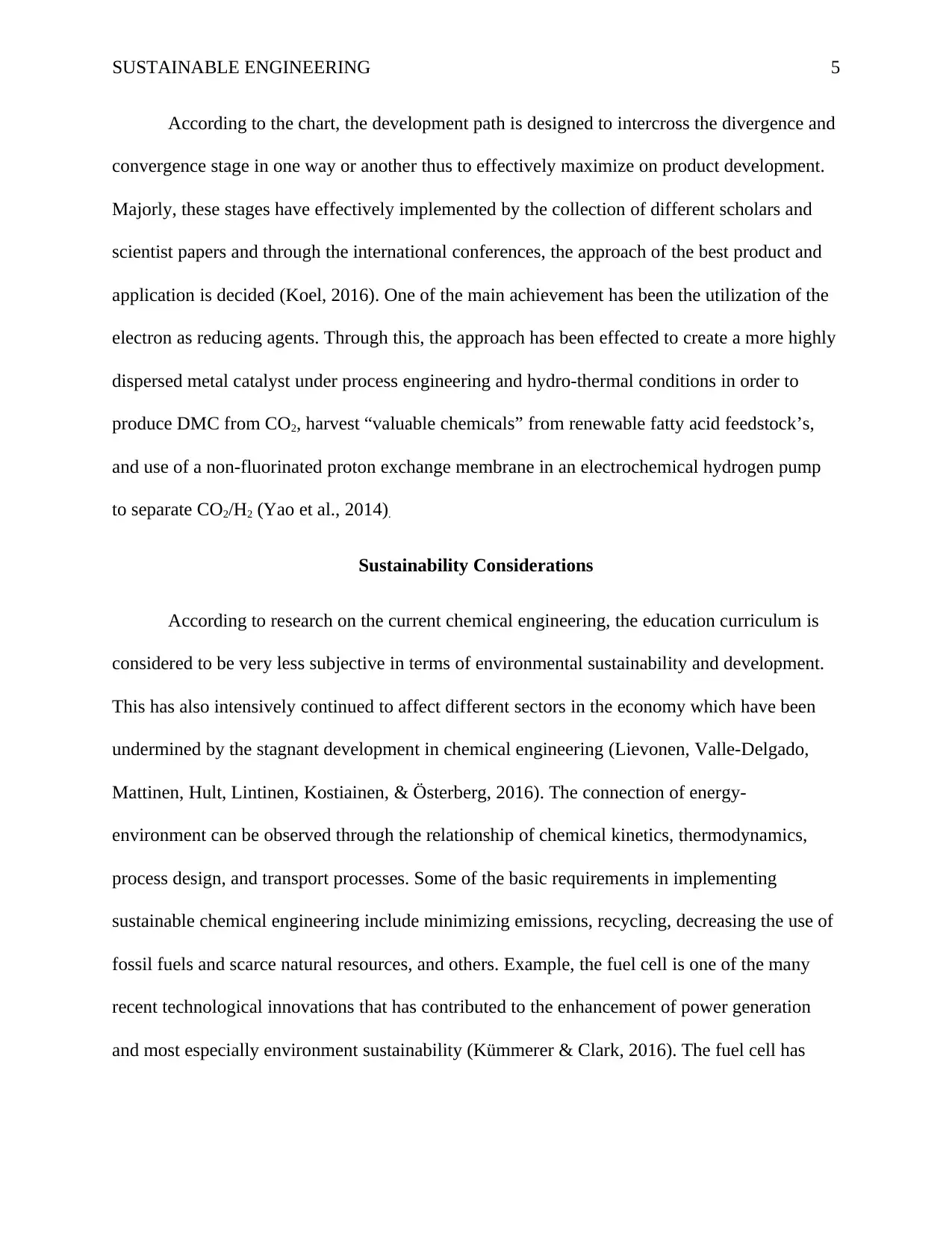
SUSTAINABLE ENGINEERING 5
According to the chart, the development path is designed to intercross the divergence and
convergence stage in one way or another thus to effectively maximize on product development.
Majorly, these stages have effectively implemented by the collection of different scholars and
scientist papers and through the international conferences, the approach of the best product and
application is decided (Koel, 2016). One of the main achievement has been the utilization of the
electron as reducing agents. Through this, the approach has been effected to create a more highly
dispersed metal catalyst under process engineering and hydro-thermal conditions in order to
produce DMC from CO2, harvest “valuable chemicals” from renewable fatty acid feedstock’s,
and use of a non-fluorinated proton exchange membrane in an electrochemical hydrogen pump
to separate CO2/H2 (Yao et al., 2014).
Sustainability Considerations
According to research on the current chemical engineering, the education curriculum is
considered to be very less subjective in terms of environmental sustainability and development.
This has also intensively continued to affect different sectors in the economy which have been
undermined by the stagnant development in chemical engineering (Lievonen, Valle-Delgado,
Mattinen, Hult, Lintinen, Kostiainen, & Österberg, 2016). The connection of energy-
environment can be observed through the relationship of chemical kinetics, thermodynamics,
process design, and transport processes. Some of the basic requirements in implementing
sustainable chemical engineering include minimizing emissions, recycling, decreasing the use of
fossil fuels and scarce natural resources, and others. Example, the fuel cell is one of the many
recent technological innovations that has contributed to the enhancement of power generation
and most especially environment sustainability (Kümmerer & Clark, 2016). The fuel cell has
According to the chart, the development path is designed to intercross the divergence and
convergence stage in one way or another thus to effectively maximize on product development.
Majorly, these stages have effectively implemented by the collection of different scholars and
scientist papers and through the international conferences, the approach of the best product and
application is decided (Koel, 2016). One of the main achievement has been the utilization of the
electron as reducing agents. Through this, the approach has been effected to create a more highly
dispersed metal catalyst under process engineering and hydro-thermal conditions in order to
produce DMC from CO2, harvest “valuable chemicals” from renewable fatty acid feedstock’s,
and use of a non-fluorinated proton exchange membrane in an electrochemical hydrogen pump
to separate CO2/H2 (Yao et al., 2014).
Sustainability Considerations
According to research on the current chemical engineering, the education curriculum is
considered to be very less subjective in terms of environmental sustainability and development.
This has also intensively continued to affect different sectors in the economy which have been
undermined by the stagnant development in chemical engineering (Lievonen, Valle-Delgado,
Mattinen, Hult, Lintinen, Kostiainen, & Österberg, 2016). The connection of energy-
environment can be observed through the relationship of chemical kinetics, thermodynamics,
process design, and transport processes. Some of the basic requirements in implementing
sustainable chemical engineering include minimizing emissions, recycling, decreasing the use of
fossil fuels and scarce natural resources, and others. Example, the fuel cell is one of the many
recent technological innovations that has contributed to the enhancement of power generation
and most especially environment sustainability (Kümmerer & Clark, 2016). The fuel cell has
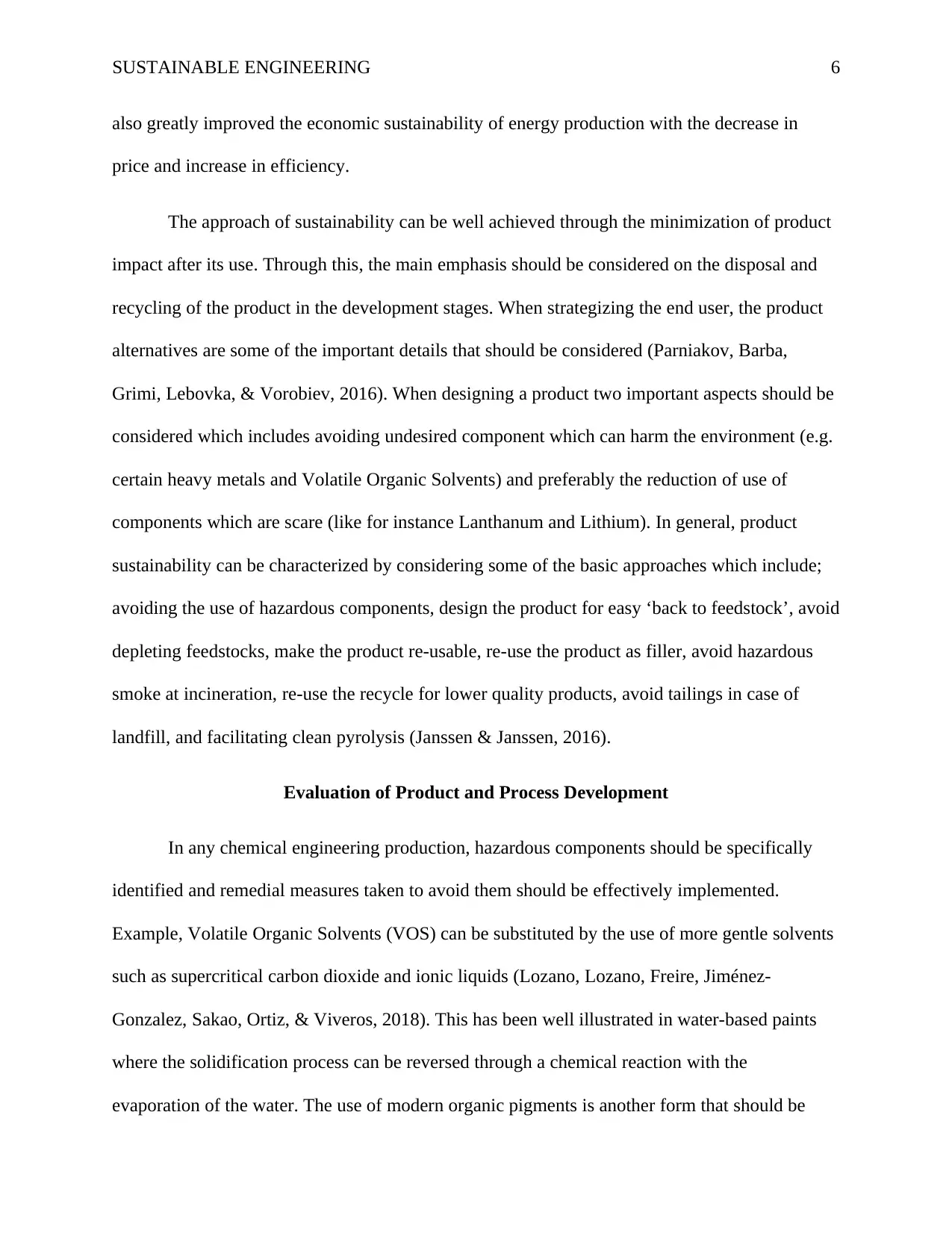
SUSTAINABLE ENGINEERING 6
also greatly improved the economic sustainability of energy production with the decrease in
price and increase in efficiency.
The approach of sustainability can be well achieved through the minimization of product
impact after its use. Through this, the main emphasis should be considered on the disposal and
recycling of the product in the development stages. When strategizing the end user, the product
alternatives are some of the important details that should be considered (Parniakov, Barba,
Grimi, Lebovka, & Vorobiev, 2016). When designing a product two important aspects should be
considered which includes avoiding undesired component which can harm the environment (e.g.
certain heavy metals and Volatile Organic Solvents) and preferably the reduction of use of
components which are scare (like for instance Lanthanum and Lithium). In general, product
sustainability can be characterized by considering some of the basic approaches which include;
avoiding the use of hazardous components, design the product for easy ‘back to feedstock’, avoid
depleting feedstocks, make the product re-usable, re-use the product as filler, avoid hazardous
smoke at incineration, re-use the recycle for lower quality products, avoid tailings in case of
landfill, and facilitating clean pyrolysis (Janssen & Janssen, 2016).
Evaluation of Product and Process Development
In any chemical engineering production, hazardous components should be specifically
identified and remedial measures taken to avoid them should be effectively implemented.
Example, Volatile Organic Solvents (VOS) can be substituted by the use of more gentle solvents
such as supercritical carbon dioxide and ionic liquids (Lozano, Lozano, Freire, Jiménez-
Gonzalez, Sakao, Ortiz, & Viveros, 2018). This has been well illustrated in water-based paints
where the solidification process can be reversed through a chemical reaction with the
evaporation of the water. The use of modern organic pigments is another form that should be
also greatly improved the economic sustainability of energy production with the decrease in
price and increase in efficiency.
The approach of sustainability can be well achieved through the minimization of product
impact after its use. Through this, the main emphasis should be considered on the disposal and
recycling of the product in the development stages. When strategizing the end user, the product
alternatives are some of the important details that should be considered (Parniakov, Barba,
Grimi, Lebovka, & Vorobiev, 2016). When designing a product two important aspects should be
considered which includes avoiding undesired component which can harm the environment (e.g.
certain heavy metals and Volatile Organic Solvents) and preferably the reduction of use of
components which are scare (like for instance Lanthanum and Lithium). In general, product
sustainability can be characterized by considering some of the basic approaches which include;
avoiding the use of hazardous components, design the product for easy ‘back to feedstock’, avoid
depleting feedstocks, make the product re-usable, re-use the product as filler, avoid hazardous
smoke at incineration, re-use the recycle for lower quality products, avoid tailings in case of
landfill, and facilitating clean pyrolysis (Janssen & Janssen, 2016).
Evaluation of Product and Process Development
In any chemical engineering production, hazardous components should be specifically
identified and remedial measures taken to avoid them should be effectively implemented.
Example, Volatile Organic Solvents (VOS) can be substituted by the use of more gentle solvents
such as supercritical carbon dioxide and ionic liquids (Lozano, Lozano, Freire, Jiménez-
Gonzalez, Sakao, Ortiz, & Viveros, 2018). This has been well illustrated in water-based paints
where the solidification process can be reversed through a chemical reaction with the
evaporation of the water. The use of modern organic pigments is another form that should be
⊘ This is a preview!⊘
Do you want full access?
Subscribe today to unlock all pages.

Trusted by 1+ million students worldwide
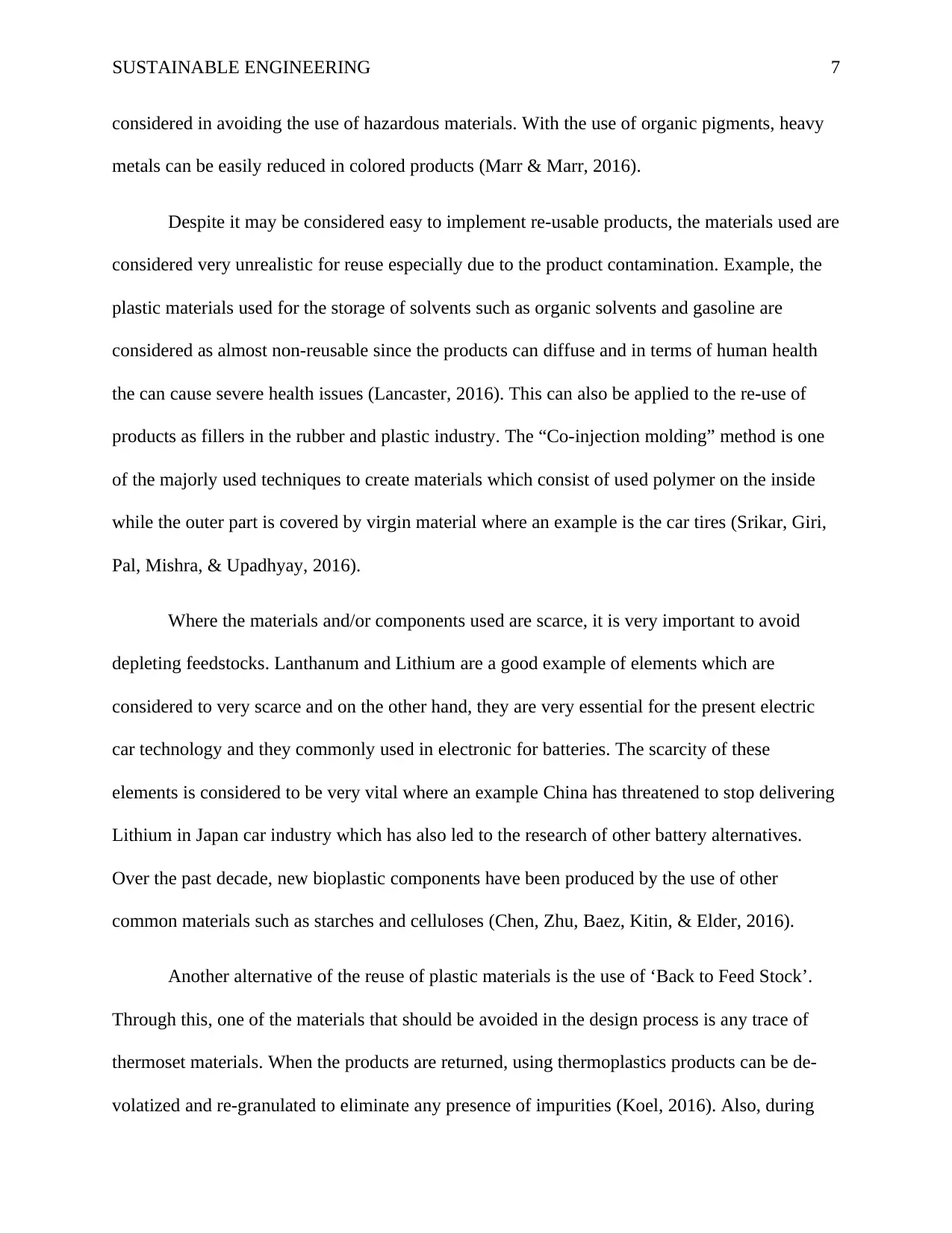
SUSTAINABLE ENGINEERING 7
considered in avoiding the use of hazardous materials. With the use of organic pigments, heavy
metals can be easily reduced in colored products (Marr & Marr, 2016).
Despite it may be considered easy to implement re-usable products, the materials used are
considered very unrealistic for reuse especially due to the product contamination. Example, the
plastic materials used for the storage of solvents such as organic solvents and gasoline are
considered as almost non-reusable since the products can diffuse and in terms of human health
the can cause severe health issues (Lancaster, 2016). This can also be applied to the re-use of
products as fillers in the rubber and plastic industry. The “Co-injection molding” method is one
of the majorly used techniques to create materials which consist of used polymer on the inside
while the outer part is covered by virgin material where an example is the car tires (Srikar, Giri,
Pal, Mishra, & Upadhyay, 2016).
Where the materials and/or components used are scarce, it is very important to avoid
depleting feedstocks. Lanthanum and Lithium are a good example of elements which are
considered to very scarce and on the other hand, they are very essential for the present electric
car technology and they commonly used in electronic for batteries. The scarcity of these
elements is considered to be very vital where an example China has threatened to stop delivering
Lithium in Japan car industry which has also led to the research of other battery alternatives.
Over the past decade, new bioplastic components have been produced by the use of other
common materials such as starches and celluloses (Chen, Zhu, Baez, Kitin, & Elder, 2016).
Another alternative of the reuse of plastic materials is the use of ‘Back to Feed Stock’.
Through this, one of the materials that should be avoided in the design process is any trace of
thermoset materials. When the products are returned, using thermoplastics products can be de-
volatized and re-granulated to eliminate any presence of impurities (Koel, 2016). Also, during
considered in avoiding the use of hazardous materials. With the use of organic pigments, heavy
metals can be easily reduced in colored products (Marr & Marr, 2016).
Despite it may be considered easy to implement re-usable products, the materials used are
considered very unrealistic for reuse especially due to the product contamination. Example, the
plastic materials used for the storage of solvents such as organic solvents and gasoline are
considered as almost non-reusable since the products can diffuse and in terms of human health
the can cause severe health issues (Lancaster, 2016). This can also be applied to the re-use of
products as fillers in the rubber and plastic industry. The “Co-injection molding” method is one
of the majorly used techniques to create materials which consist of used polymer on the inside
while the outer part is covered by virgin material where an example is the car tires (Srikar, Giri,
Pal, Mishra, & Upadhyay, 2016).
Where the materials and/or components used are scarce, it is very important to avoid
depleting feedstocks. Lanthanum and Lithium are a good example of elements which are
considered to very scarce and on the other hand, they are very essential for the present electric
car technology and they commonly used in electronic for batteries. The scarcity of these
elements is considered to be very vital where an example China has threatened to stop delivering
Lithium in Japan car industry which has also led to the research of other battery alternatives.
Over the past decade, new bioplastic components have been produced by the use of other
common materials such as starches and celluloses (Chen, Zhu, Baez, Kitin, & Elder, 2016).
Another alternative of the reuse of plastic materials is the use of ‘Back to Feed Stock’.
Through this, one of the materials that should be avoided in the design process is any trace of
thermoset materials. When the products are returned, using thermoplastics products can be de-
volatized and re-granulated to eliminate any presence of impurities (Koel, 2016). Also, during
Paraphrase This Document
Need a fresh take? Get an instant paraphrase of this document with our AI Paraphraser
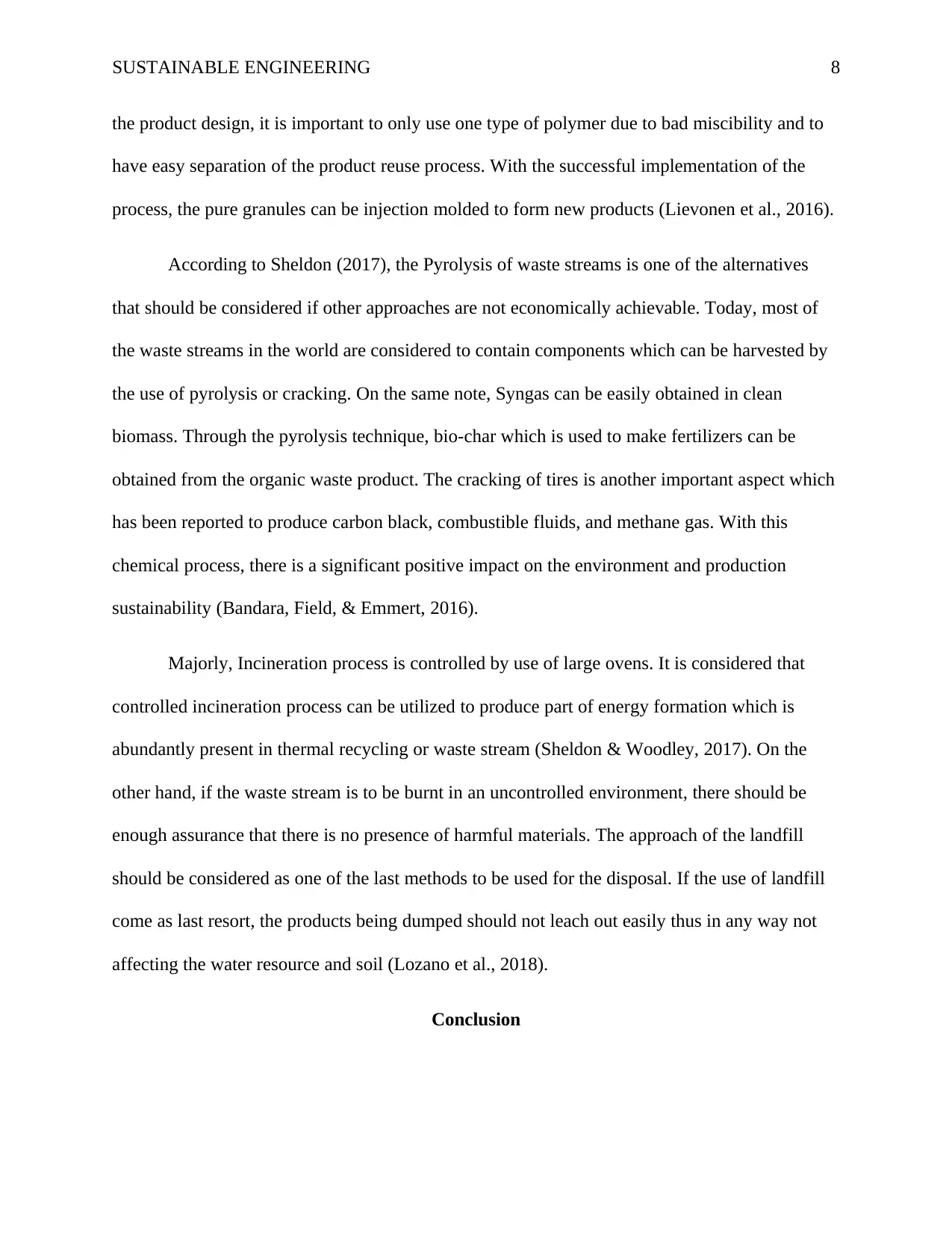
SUSTAINABLE ENGINEERING 8
the product design, it is important to only use one type of polymer due to bad miscibility and to
have easy separation of the product reuse process. With the successful implementation of the
process, the pure granules can be injection molded to form new products (Lievonen et al., 2016).
According to Sheldon (2017), the Pyrolysis of waste streams is one of the alternatives
that should be considered if other approaches are not economically achievable. Today, most of
the waste streams in the world are considered to contain components which can be harvested by
the use of pyrolysis or cracking. On the same note, Syngas can be easily obtained in clean
biomass. Through the pyrolysis technique, bio-char which is used to make fertilizers can be
obtained from the organic waste product. The cracking of tires is another important aspect which
has been reported to produce carbon black, combustible fluids, and methane gas. With this
chemical process, there is a significant positive impact on the environment and production
sustainability (Bandara, Field, & Emmert, 2016).
Majorly, Incineration process is controlled by use of large ovens. It is considered that
controlled incineration process can be utilized to produce part of energy formation which is
abundantly present in thermal recycling or waste stream (Sheldon & Woodley, 2017). On the
other hand, if the waste stream is to be burnt in an uncontrolled environment, there should be
enough assurance that there is no presence of harmful materials. The approach of the landfill
should be considered as one of the last methods to be used for the disposal. If the use of landfill
come as last resort, the products being dumped should not leach out easily thus in any way not
affecting the water resource and soil (Lozano et al., 2018).
Conclusion
the product design, it is important to only use one type of polymer due to bad miscibility and to
have easy separation of the product reuse process. With the successful implementation of the
process, the pure granules can be injection molded to form new products (Lievonen et al., 2016).
According to Sheldon (2017), the Pyrolysis of waste streams is one of the alternatives
that should be considered if other approaches are not economically achievable. Today, most of
the waste streams in the world are considered to contain components which can be harvested by
the use of pyrolysis or cracking. On the same note, Syngas can be easily obtained in clean
biomass. Through the pyrolysis technique, bio-char which is used to make fertilizers can be
obtained from the organic waste product. The cracking of tires is another important aspect which
has been reported to produce carbon black, combustible fluids, and methane gas. With this
chemical process, there is a significant positive impact on the environment and production
sustainability (Bandara, Field, & Emmert, 2016).
Majorly, Incineration process is controlled by use of large ovens. It is considered that
controlled incineration process can be utilized to produce part of energy formation which is
abundantly present in thermal recycling or waste stream (Sheldon & Woodley, 2017). On the
other hand, if the waste stream is to be burnt in an uncontrolled environment, there should be
enough assurance that there is no presence of harmful materials. The approach of the landfill
should be considered as one of the last methods to be used for the disposal. If the use of landfill
come as last resort, the products being dumped should not leach out easily thus in any way not
affecting the water resource and soil (Lozano et al., 2018).
Conclusion
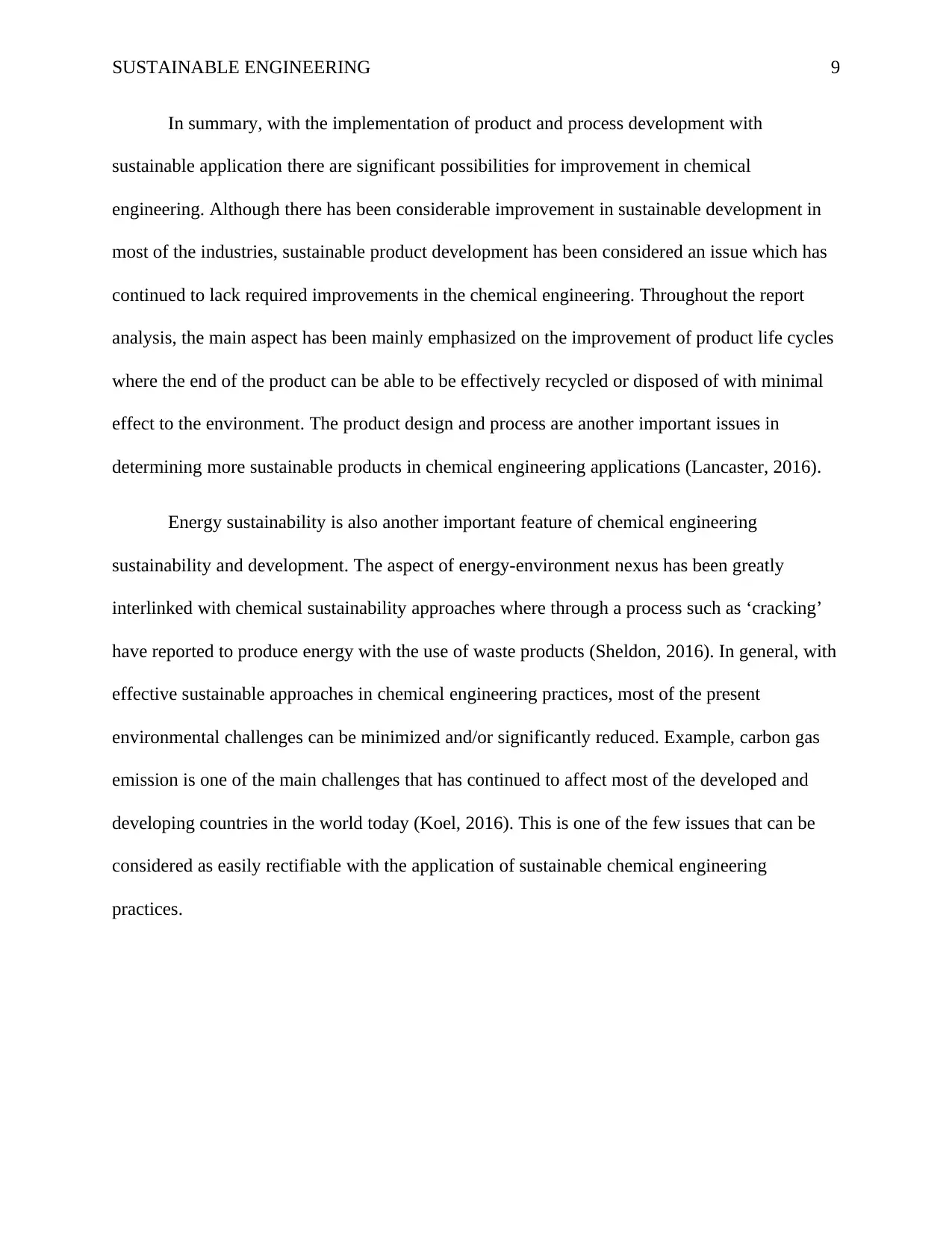
SUSTAINABLE ENGINEERING 9
In summary, with the implementation of product and process development with
sustainable application there are significant possibilities for improvement in chemical
engineering. Although there has been considerable improvement in sustainable development in
most of the industries, sustainable product development has been considered an issue which has
continued to lack required improvements in the chemical engineering. Throughout the report
analysis, the main aspect has been mainly emphasized on the improvement of product life cycles
where the end of the product can be able to be effectively recycled or disposed of with minimal
effect to the environment. The product design and process are another important issues in
determining more sustainable products in chemical engineering applications (Lancaster, 2016).
Energy sustainability is also another important feature of chemical engineering
sustainability and development. The aspect of energy-environment nexus has been greatly
interlinked with chemical sustainability approaches where through a process such as ‘cracking’
have reported to produce energy with the use of waste products (Sheldon, 2016). In general, with
effective sustainable approaches in chemical engineering practices, most of the present
environmental challenges can be minimized and/or significantly reduced. Example, carbon gas
emission is one of the main challenges that has continued to affect most of the developed and
developing countries in the world today (Koel, 2016). This is one of the few issues that can be
considered as easily rectifiable with the application of sustainable chemical engineering
practices.
In summary, with the implementation of product and process development with
sustainable application there are significant possibilities for improvement in chemical
engineering. Although there has been considerable improvement in sustainable development in
most of the industries, sustainable product development has been considered an issue which has
continued to lack required improvements in the chemical engineering. Throughout the report
analysis, the main aspect has been mainly emphasized on the improvement of product life cycles
where the end of the product can be able to be effectively recycled or disposed of with minimal
effect to the environment. The product design and process are another important issues in
determining more sustainable products in chemical engineering applications (Lancaster, 2016).
Energy sustainability is also another important feature of chemical engineering
sustainability and development. The aspect of energy-environment nexus has been greatly
interlinked with chemical sustainability approaches where through a process such as ‘cracking’
have reported to produce energy with the use of waste products (Sheldon, 2016). In general, with
effective sustainable approaches in chemical engineering practices, most of the present
environmental challenges can be minimized and/or significantly reduced. Example, carbon gas
emission is one of the main challenges that has continued to affect most of the developed and
developing countries in the world today (Koel, 2016). This is one of the few issues that can be
considered as easily rectifiable with the application of sustainable chemical engineering
practices.
⊘ This is a preview!⊘
Do you want full access?
Subscribe today to unlock all pages.

Trusted by 1+ million students worldwide
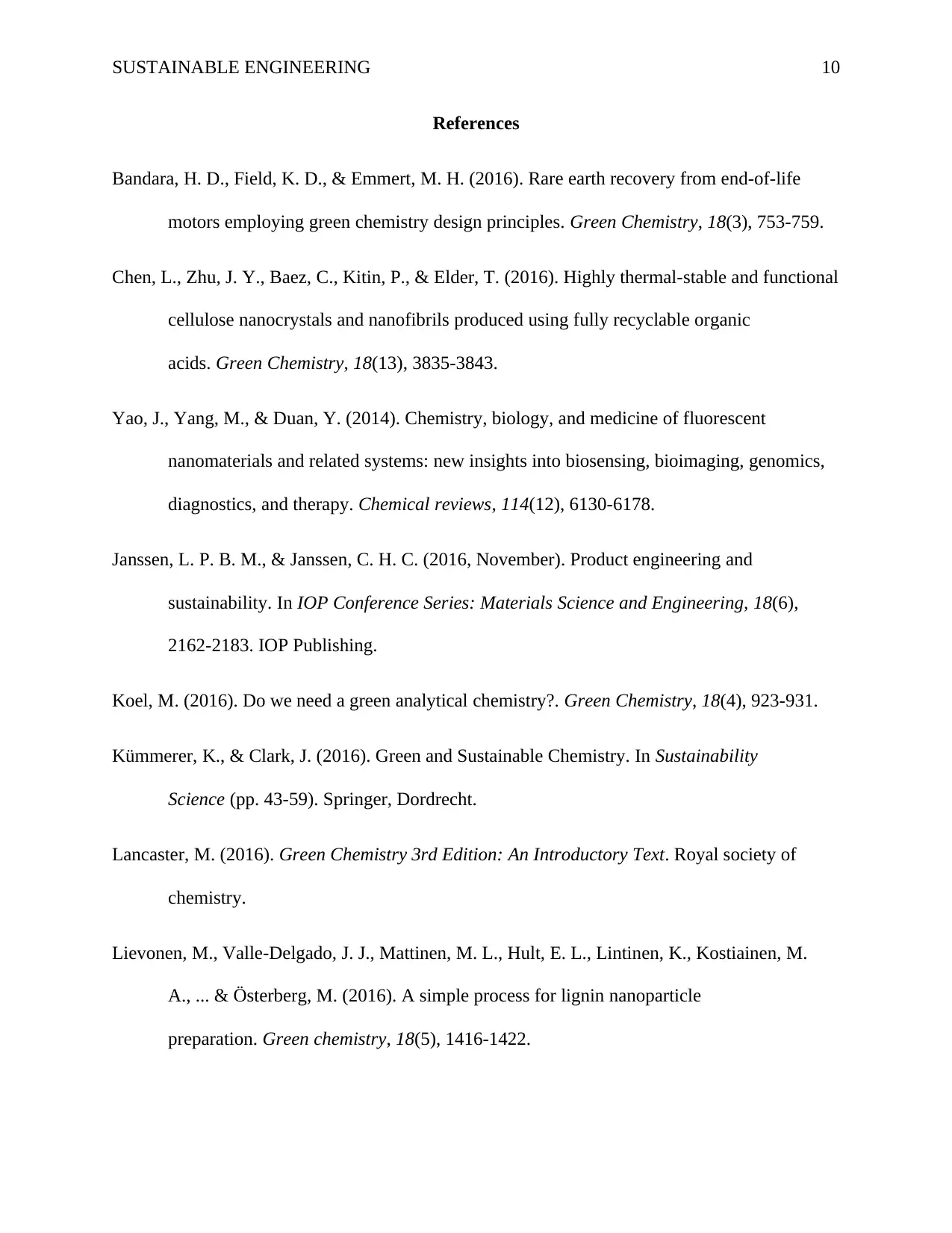
SUSTAINABLE ENGINEERING 10
References
Bandara, H. D., Field, K. D., & Emmert, M. H. (2016). Rare earth recovery from end-of-life
motors employing green chemistry design principles. Green Chemistry, 18(3), 753-759.
Chen, L., Zhu, J. Y., Baez, C., Kitin, P., & Elder, T. (2016). Highly thermal-stable and functional
cellulose nanocrystals and nanofibrils produced using fully recyclable organic
acids. Green Chemistry, 18(13), 3835-3843.
Yao, J., Yang, M., & Duan, Y. (2014). Chemistry, biology, and medicine of fluorescent
nanomaterials and related systems: new insights into biosensing, bioimaging, genomics,
diagnostics, and therapy. Chemical reviews, 114(12), 6130-6178.
Janssen, L. P. B. M., & Janssen, C. H. C. (2016, November). Product engineering and
sustainability. In IOP Conference Series: Materials Science and Engineering, 18(6),
2162-2183. IOP Publishing.
Koel, M. (2016). Do we need a green analytical chemistry?. Green Chemistry, 18(4), 923-931.
Kümmerer, K., & Clark, J. (2016). Green and Sustainable Chemistry. In Sustainability
Science (pp. 43-59). Springer, Dordrecht.
Lancaster, M. (2016). Green Chemistry 3rd Edition: An Introductory Text. Royal society of
chemistry.
Lievonen, M., Valle-Delgado, J. J., Mattinen, M. L., Hult, E. L., Lintinen, K., Kostiainen, M.
A., ... & Österberg, M. (2016). A simple process for lignin nanoparticle
preparation. Green chemistry, 18(5), 1416-1422.
References
Bandara, H. D., Field, K. D., & Emmert, M. H. (2016). Rare earth recovery from end-of-life
motors employing green chemistry design principles. Green Chemistry, 18(3), 753-759.
Chen, L., Zhu, J. Y., Baez, C., Kitin, P., & Elder, T. (2016). Highly thermal-stable and functional
cellulose nanocrystals and nanofibrils produced using fully recyclable organic
acids. Green Chemistry, 18(13), 3835-3843.
Yao, J., Yang, M., & Duan, Y. (2014). Chemistry, biology, and medicine of fluorescent
nanomaterials and related systems: new insights into biosensing, bioimaging, genomics,
diagnostics, and therapy. Chemical reviews, 114(12), 6130-6178.
Janssen, L. P. B. M., & Janssen, C. H. C. (2016, November). Product engineering and
sustainability. In IOP Conference Series: Materials Science and Engineering, 18(6),
2162-2183. IOP Publishing.
Koel, M. (2016). Do we need a green analytical chemistry?. Green Chemistry, 18(4), 923-931.
Kümmerer, K., & Clark, J. (2016). Green and Sustainable Chemistry. In Sustainability
Science (pp. 43-59). Springer, Dordrecht.
Lancaster, M. (2016). Green Chemistry 3rd Edition: An Introductory Text. Royal society of
chemistry.
Lievonen, M., Valle-Delgado, J. J., Mattinen, M. L., Hult, E. L., Lintinen, K., Kostiainen, M.
A., ... & Österberg, M. (2016). A simple process for lignin nanoparticle
preparation. Green chemistry, 18(5), 1416-1422.
Paraphrase This Document
Need a fresh take? Get an instant paraphrase of this document with our AI Paraphraser
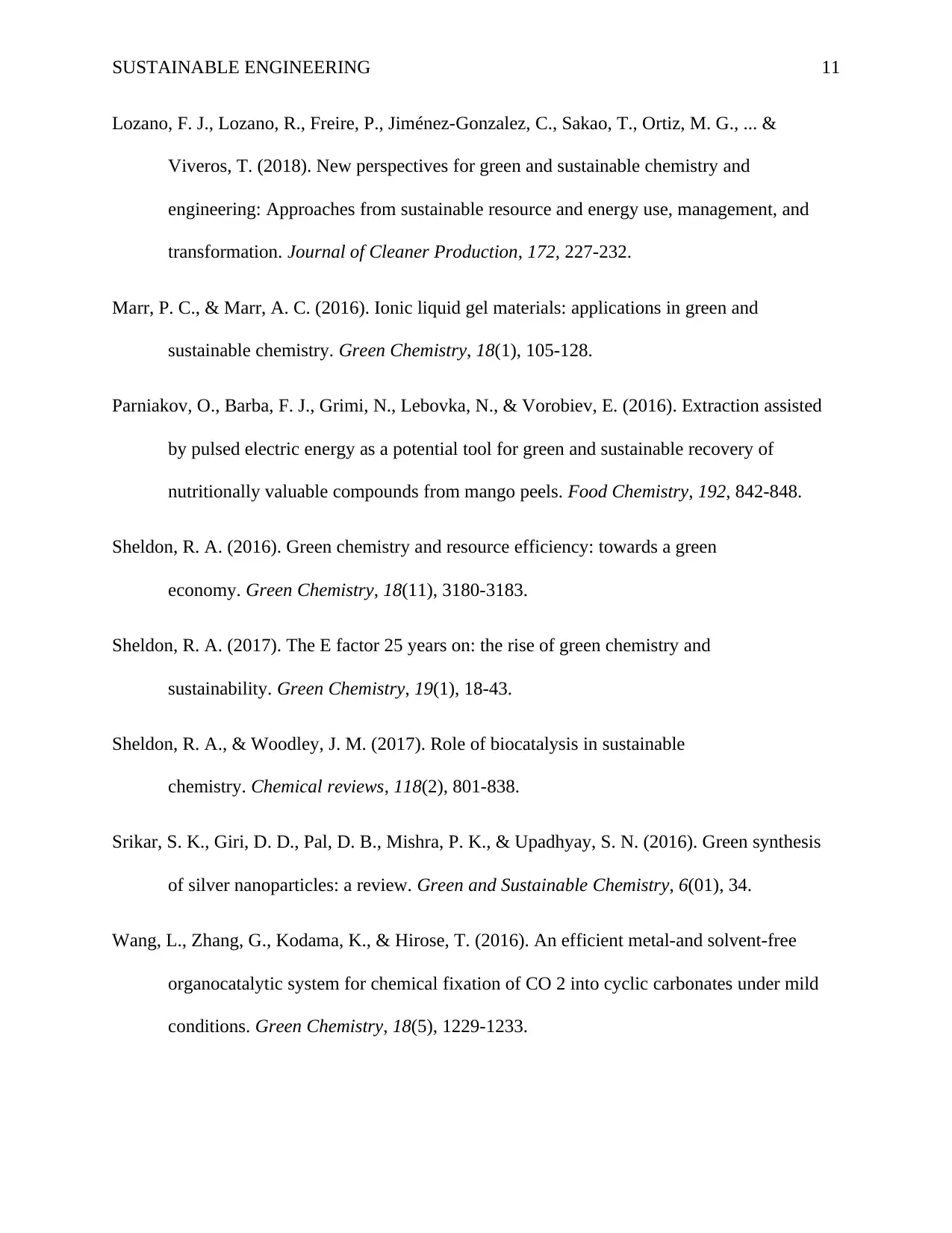
SUSTAINABLE ENGINEERING 11
Lozano, F. J., Lozano, R., Freire, P., Jiménez-Gonzalez, C., Sakao, T., Ortiz, M. G., ... &
Viveros, T. (2018). New perspectives for green and sustainable chemistry and
engineering: Approaches from sustainable resource and energy use, management, and
transformation. Journal of Cleaner Production, 172, 227-232.
Marr, P. C., & Marr, A. C. (2016). Ionic liquid gel materials: applications in green and
sustainable chemistry. Green Chemistry, 18(1), 105-128.
Parniakov, O., Barba, F. J., Grimi, N., Lebovka, N., & Vorobiev, E. (2016). Extraction assisted
by pulsed electric energy as a potential tool for green and sustainable recovery of
nutritionally valuable compounds from mango peels. Food Chemistry, 192, 842-848.
Sheldon, R. A. (2016). Green chemistry and resource efficiency: towards a green
economy. Green Chemistry, 18(11), 3180-3183.
Sheldon, R. A. (2017). The E factor 25 years on: the rise of green chemistry and
sustainability. Green Chemistry, 19(1), 18-43.
Sheldon, R. A., & Woodley, J. M. (2017). Role of biocatalysis in sustainable
chemistry. Chemical reviews, 118(2), 801-838.
Srikar, S. K., Giri, D. D., Pal, D. B., Mishra, P. K., & Upadhyay, S. N. (2016). Green synthesis
of silver nanoparticles: a review. Green and Sustainable Chemistry, 6(01), 34.
Wang, L., Zhang, G., Kodama, K., & Hirose, T. (2016). An efficient metal-and solvent-free
organocatalytic system for chemical fixation of CO 2 into cyclic carbonates under mild
conditions. Green Chemistry, 18(5), 1229-1233.
Lozano, F. J., Lozano, R., Freire, P., Jiménez-Gonzalez, C., Sakao, T., Ortiz, M. G., ... &
Viveros, T. (2018). New perspectives for green and sustainable chemistry and
engineering: Approaches from sustainable resource and energy use, management, and
transformation. Journal of Cleaner Production, 172, 227-232.
Marr, P. C., & Marr, A. C. (2016). Ionic liquid gel materials: applications in green and
sustainable chemistry. Green Chemistry, 18(1), 105-128.
Parniakov, O., Barba, F. J., Grimi, N., Lebovka, N., & Vorobiev, E. (2016). Extraction assisted
by pulsed electric energy as a potential tool for green and sustainable recovery of
nutritionally valuable compounds from mango peels. Food Chemistry, 192, 842-848.
Sheldon, R. A. (2016). Green chemistry and resource efficiency: towards a green
economy. Green Chemistry, 18(11), 3180-3183.
Sheldon, R. A. (2017). The E factor 25 years on: the rise of green chemistry and
sustainability. Green Chemistry, 19(1), 18-43.
Sheldon, R. A., & Woodley, J. M. (2017). Role of biocatalysis in sustainable
chemistry. Chemical reviews, 118(2), 801-838.
Srikar, S. K., Giri, D. D., Pal, D. B., Mishra, P. K., & Upadhyay, S. N. (2016). Green synthesis
of silver nanoparticles: a review. Green and Sustainable Chemistry, 6(01), 34.
Wang, L., Zhang, G., Kodama, K., & Hirose, T. (2016). An efficient metal-and solvent-free
organocatalytic system for chemical fixation of CO 2 into cyclic carbonates under mild
conditions. Green Chemistry, 18(5), 1229-1233.
1 out of 11
Related Documents
Your All-in-One AI-Powered Toolkit for Academic Success.
+13062052269
info@desklib.com
Available 24*7 on WhatsApp / Email
![[object Object]](/_next/static/media/star-bottom.7253800d.svg)
Unlock your academic potential
Copyright © 2020–2025 A2Z Services. All Rights Reserved. Developed and managed by ZUCOL.





